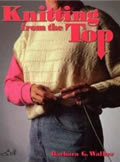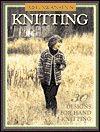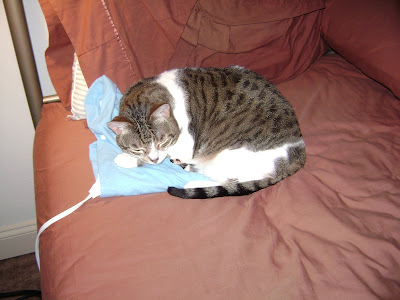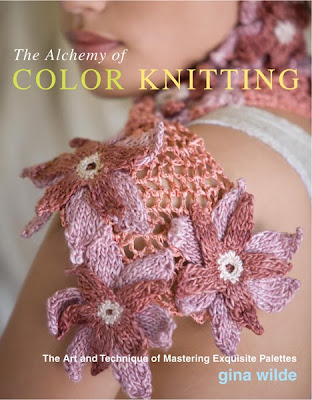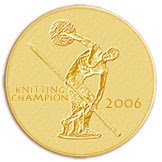(How did it get to be 2010? Really?)
Welcome to possibly my last VK review. I'm not sure I'm going to continue them; I've hit super-high disgust levels with this issue. The
letter from the editor is insulting, the designs are hyped to be something they're not, and, well, I'm disgusted. We'll see.
There seems to be (still) some confusion over 'blame' and all that. When it comes to the models, I think they're doing their jobs. They show up, they put on the clothes they're handed, and they make them look as good as possible. In some cases (I'll discuss it in detail with the photos), I actively feel sorry for them. So who do I really think is to blame for bad photography? Trisha Malcom is the editor in chief and supposedly the final word on what goes into the magazine. Creative director, Joe Vior. Fashion Stylist, Sarah Liebowitz. Photographers vary and aren't listed, but them too. They're the ones who decide on this mess. I'm sure there are a lot of others involved at the decision-making level. The models and designers? They're just trying to make a living.
My biggest beef with this issue is the one I have with Vogue Knitting in general: Quite a bit of what is in the magazine this time around is perfectly fine, wearable stuff. But it is NOT high fashion, haute anything, or even particularly stylish. They're going with Big Names rather than good clothes, and they're unwilling to pay designers to do truly original work. (For that, look to yarn company publications.) They also use knitting terminology in a way that shows that at least the copywriters have no idea how knitting really works, and I seriously wonder about that claim in the editor's letter that "almost everyone here knits".
As always, I refer to patterns by number, not page, and anything in quotes is from the magazine.
Advertising is full of good-looking sweaters knit at mostly smaller gauges in intelligent silhouettes (fairly fitted; long sleeves for cold weather, etc).
The 'new yarns' section is a couple balls of Rowan's Scottish Tweed plunked down on a white background. No one could be bothered to knit a swatch? There's a list of other tweed yarns on the page, but no one could be bothered to include even a photo of those, either.
The article from Meg Swansen's son, Cully, completes the three-part series of grandmother, mother, and son hat designs. His is two-colored cables, and very cool looking. He says he's getting into knitting more, and is fascinated by the geometry of it. He's got a new pullover pattern coming out with Schoolhouse Press; it should be fun to watch him start designing and see what he does.
Techniques discusses The Thumb Trick and corrugated ribbing, used on the mittens in this issue. I'm rather disgusted that The Thumb Trick part doesn't even call it that, and never mentions Elizabeth Zimmerman, considering she invented it.
So, the patterns.
First section, "Knit drama. Knit exuberance. Knit Vogue." I may not sneer if I saw any of those qualities in any design in the magazine. "Sweater season is no time to be shy. Flaunt your stitching in high style, with striking color and fabulous fiber." Striking color, yet every design in this section is gray and cream. I really wonder if the copywriters have ANY idea what they're writing about, or if they just spew stuff out like monkeys at typewriters trying to produce Shakespeare.
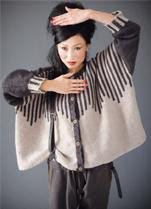
1. Striped cardigan by Brandon Mably. One size, 67in/170cm. Uses 1824 wool, which makes it almost affordable ($140 USD, not bad for all that acreage of fabric). I hate to ruin it for everyone who hated this, but it's actually a solid design. My
Starry Night Ruana Thingy is based on the same cut, and while it will never be body conscious, it is comfortable and warm. What makes it look stupid is how they've got the model standing, and that asinine suspender the stylist hooked up over it. (It's supposed to hang loosely, so you put a suspender over it. Brilliant.)

2. Shawl collar cardigan by Cathy Caron. 34 to 49in/86 to 125cm. This isn't bad. It's not earth-shattering high fashion, but it's a nice enough cardigan if you go for that. The dark band around the waist combined with the light color of the sleeves flatters blockier figures. The photo, though... it looks like there's a pole up the model's... uh. Well. I flipped to this page and actively felt sorry for the model.

3. Cowl neck pullover, by Mari Lynn Patrick. Sizes from 49 to 53in/124 to 134cm. Now I ask you. Who would this flatter? The model looks like a woolly mammoth. Why would anyone larger look any better? There's nothing wrong with this if you're looking for a sweatshirt to knock around in, but if that's style, I'll eat it.

4. Fair isle tunic by Jean Moss. No idea what's up with the Sailor Moon pose with the model. Sizes from 35 to 43in/89 to 109 cm. Without exhaustive tech editing, a look at the pattern shows no mention whatsoever of steeks, and I think you're meant to knit all that stranded color back and forth. Awkward to knit AND awkward to wear. If you lopped this off at the waist and put in some regular ribbing there, this'd make a cute short-sleeved sweater vest sort of thing.
Second section, "The Exotic Allure of the Traditional." They're mining old, traditional patterns and trying to convince us they're high fashion. "Timeless colorwork. Contemporary fibers and shapes. Fair Isle is having its moment... again." As usual they apply the term Fair Isle to any stranded color work, when really only about half (or less) of these patterns are truly Fair Isle.

5. Flowered vest by Kathy Merrick. Sizes from 36 to 51 inches/91 to 129cm. This isn't Fair Isle. If anything, it's Norwegian inspired. Those flowers are almost Norwegian stars. No mention here of steeks, either. More stranded color worked flat. If you're looking for a fairly traditional vest to keep warm this winter, this one is nice enough.

6. V-neck pullover by Lisa Whiting. Sizes from 35 to 49in/89 to 125cm. This IS a Fair Isle, in that it's got the bands of color over patterns based on (loosely in this case, but it's there) the XOs of the older Fair Isles. It DOES use steeks (the yarn is alpaca, so I'd use a sewn steek here, preferably with a sewing machine, to make sure that slippery alpaca stays put). I've read the pattern and still don't understand how the sleeves work. And, well, if the model doesn't look like she has a waist... I'd use this as inspiration for a regular long-sleeved V neck myself.

7. Floral Cardigan, by Josh Bennett. Sizes from 34 to 44in/86 to 111cm. "Visit our website for back, fronts, and sleeve charts." It's a nice enough cardigan. I'd like it more if some attempt had been made to match up the flowers at the shoulders, instead of a jumble of cut up flower bits sewn together. (If you did this top down and used the charts as a general guideline, you could make the flowers work at the shoulders.) It's intarsia, by the way. Which isn't, you know, remotely related to Fair Isle.

8. Fair Isle Cardigan, by Heidi Kozar. Sizes, 36 to 53in/93 to 136cm. The patterns make the Fair Isle label sketchy, but it IS knit in stranded color technique with steeks. Which is kind of impressive, because it's got shaped sleeve caps and waist shaping. This would look good on most everyone who could fit into it.
Section three, "GRAY! A smoky hot trend." Har. "When it comes to showing off sophisticated stitchwork, shades of gray matter." Every last pattern in this section makes the model look like a stump. It's kind of impressive, really. In a weird sort of way.

9. Tunic Vest by Mari Lynn Patrick. Sizes 35 to 40in/89 to 103cm. That's ridiculously small, even for Vogue, considering it's meant to go over other stuff. You can't see it in the photo here, but on Vogue 360, it shows the pockets don't even line up, and the whole thing bags around the model's hips. Just what a girl wants; baggy hips.

10. Belted tunic by Rosemary Drysdale. Sizes from 46 to 54in/118 to 138cm. On Vogue 360, the model looks pregnant in this. If you've GOT to knit it, knit the belt differently. That thing is as big around as my arm, and will do NOTHING to accentuate your waist. It'd be like wrapping yourself in a fire hose.
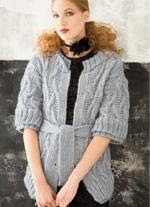
11. Cabled cardigan by Shiri Mor. Sizes, 34 to 52in/86 to 132cm. All the ribbing on this thing is doubled; there are two layers of it. Not folded over for extra stretch, just extra ribbing on top of what's there. I'd use that yarn to lengthen the sleeves, myself.
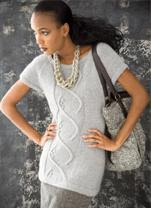
12. Cable panel tunic by Suvi Simola. Sizes, 33 to 51in/84 to 131cm. This is nice. I'm not sure the length is flattering to most, I'd consider knocking off some of the length. But this is really nice as a layering piece for winter. It's knit with wool/alpaca blend so it's plenty warm. (And on a personal note, I covet the necklace. It looks knit. Totally cool.)

13. Cabled vest by Karen Garlinghouse. "Texture gravitates toward the gray scale, from slate to putty." What? That doesn't even make sense. If I were the designer I'd want to beat my head on a desk. Sizes, 35 to 43in/90 to 110cm. It's a hippy vest. I wish they'd quit publishing these things, because they're never flattering. (I almost did a hippy vest montage here, but reason prevailed. Plus I didn't want to add another hour to this review.) The model is wearing a belt and still looks like she has no waist. Not what I personally want to wear.

14. Modular vest by Lori Steinburg. Sizes, 36 to 42in/91 to 106cm. (We get into directional knitting, and the sizing starts dropping off dramatically.) This is potentially very cool. The stitch patterns all work together in a really clever way, to make all sorts of interesting textures. Here's what worries me, though: see how she's using her right hand to hang on to the bottom front hem? You can't see it well in this photo, but it's more obvious on Vogue 360 and in the magazine. I think the zipper was put in wrong. The front flares out, and the edgings along the front don't line up. The front join is also wavy and crooked without the model jerking it straight. So I wonder, if THEY can't get the zipper to work and they're THE PROFESSIONALS, how much of a pain in the ass would it be for me?
Next up, Twinkle. "Twinkle turns up the volume. Simple styling takes shape in voluptuous yarn." If this is style, I'll eat it.

15. Sleeveless vest with hood. By Twinkle. Sizes, 60 and 67in/and isn't this cute, two sizes in Imperial and only one size in metric, 171cm. Yuh huh. $152 USD to knit the smaller size (which apparently only comes in Imperial). The only thing I can think of when I look at this is BAGGY. Look at this:
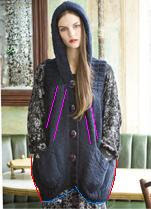
See the pink/purple lines from shoulders down? Those are big folds of inch-thick fabric, flopping around on the model's chest. See the blue lines at the bottom hem? It doesn't even hang straight. The central edging with buttons sort of sucks up the fabric, then it bags out from there in all directions. See the red lines at the model's butt? That's more fabric, bagging out around her keester. I suppose this is all right for knocking around the house while trying to stay warm, but how in HELL is this fashion? Isn't fashion supposed to look at least remotely good? How is making a stick-thin model look like she's wearing a sack, fashion? (Don't tell me it's a bubble silhouette. Just don't. It's not a bubble, it's a bag.)
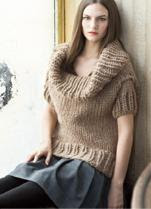
16. Cowl neck top, again by Twinkle. Sizes, 43 to 50in/109 to 128cm. $114 USD for size medium (the yarn is $19 per skein). Look at the model. JUST LOOK AT HER. And tell me anyone else would look any better? Over at Vogue 360 they were showing this one INSIDE OUT. Oh yes, they're professional and know how to dress us, all right. (They've since fixed it. Too bad; it was funny.)
Section next, "Boy Meets Purl". Interview with Josh Bennett about his design philosophy and background. He says he wants to design wearable clothes for men. A worthy goal. Thing is, most men don't like high fashion, and 'wearable for men' and 'Vogue' are kind of contradictory. At least to all the men I know.

17. Man's cable cardigan, by Josh Bennett. Sizes, 38 to 45in/96 to 114cm. Those sizes seem pretty small to me, but I know a lot of big, broad-chested men. The husbeast couldn't fit into the largest size, not remotely. This is a nice, comfy sweater. Bennett himself calls it a "Grandpa" sweater with a "homey, down-to-earth Mr. Rogers feel". He's not kidding.

Slap a zipper in there, and it's literally Mr. Rogers. Now I'm not criticizing comfort or homey (in fact I live by them), but how on earth is this high fashion? Seriously? Mr. Rogers? REALLY?

18. Striped hoodie, by Bennett. Sizes, 40 to 50in/103 to 127. Again to quote Bennett, this is "a casual, throw it on to go to Whole Foods feel". See above about high fashion and I don't get it. They're very careful in the magazine and on Vogue 360 to hide it, but the zipper's in crooked and the bottom stripes don't match up.

19. Men's vest by Bennett. Sizes, 34 to 50in/86 to 127cm. I'm trying to think if I know any males over the age of 14 who have 34 inch chests. Anyway. Anyway. Knit with a nice merino, and is a nice, if stereotypical men's sweater vest. Shaping is done by working stranded color flat, rather than steeking it. So the bottom half is knit in the round, and the top half is worked flat in sections. If you knit this, beware the huge gauge shift most people have between working in the round and working flat.
Section, ah, next, "Country Living". "Great style happens when pretty cardis take a weekend break." There are some gems in here; a girl can never have too many flattering cardigans. On the other hand... country living? Apparently no one in the art department has ever mucked out a barn, if they think this is country living.

20. Lace edge cardi by Coralie Meslin. Sizes from 36 to 54in/93 to 139cm. I really like the concept of this. The lace edge adds that all-important vertical line, and if you decide to leave the lace off, it's a solid design for a plain stockinette cardigan that could be dressed up with a scarf or fancy buttons. If you DO put the lace on, have a care; on the model, they've got the lace pinned or sewn down all the way up around the neck, where it has to curve about. Knitting the lace in a thinner yarn, on larger needles, would help with that.

21. Ruffled cardigan by Shirley Paden. Sizes, 37 and 43in/94 and 109cm. (Again, the lace complicates the re-sizing and size choice drops off steeply. Not that anyone, even smaller sizes, would look good in this. But still.) The husbeast took a look at this and said "Dude. That looks like rhumba pants gone wrong." Rhumba pants being these:

He knows about rhumba pants because he's got a little girl, and he considers them the most ridiculous garment ever invented. Anyway. Ruffles about the waist. We've had this discussion before, and the gist of it is, they're horribly unflattering. Look at the model. Two inches of bulk, all the way around her hips. NOT a good look. If I was hellbent on knitting this, I'd leave off the bottom two ruffles and work the waist fitting so that it, well, fits.

22. Fitted jacket by Jennie Atkinson. Sizes, 37 to 51in/95 to 103cm. Yup. That's what it is, a fitted jacket. The cables accentuating the waist would be flattering to just about everyone, and there's a little half-belt in the back (like on a men's vest) that could be worked to pull in and fine-tune the waist fitting. This is really nice. No idea why the stylist put that belt on it; all it does is obscure the shaping and make it hard to figure out.

23. Cabled yoke cardi by Amy Polcyn. Sizes, 34 to 38in/86 to 96cm. (Again with the complex pattern = almost no sizes.) This is a nice cardigan. The only thing wrong with it is, if you unbuttoned it, it'd fall off your shoulders. If you're okay with that, then it's fine. A note of caution: The cable in the yoke is knit sideways, then stitches are picked up on each side and knit in either direction. Considering this is a mohair yarn (not entirely mohair, but it's in there), picking up those stitches could be a real pain in the keester. Just saying. I'd also skip the ribbing in the body of the sweater. It's doing nothing to help fit and just looks strange.

24. Raglan cardigan by Tanis Gray. Sizes, 32 to 52in/81 to 132cm. Another nice little cropped cardigan. I'd consider leaving off the stylized front pockets, since they're not good for anything but adding bulk at your waist. But it's cute, it's flattering enough (no waist shaping, but it's easily added), and it's in a decent variety of sizes.

25. Wide rib cardigan, by Edna Hart. 36 to 50in/91 to 127cm. (There are only three sizes at seven inch/fifteen cm ish increments. Not necessarily flattering.) This is another time I feel sorry for the model. Good grief, that pose. She looks like a pregnant lady with a sore back. The cardigan is just what it says it is; a wide rib cardi. Not high fashion, but nothing wrong with it.
Next pattern, "Sculpted Glamour". Its a sort of mini workshop teaching short rows for shaping. I wonder why it's not in the front with the other techniques articles, but it's useful information.

26. Ribbed cardigan by Karola Gottwald. Sizes, 35 to 53in/90 to 135cm. There's not much (almost no) shaping to this thing, other than some extra fullness around the neckline. All shape comes from the body in it. So it's going to look magnificent on curvy, hourglass-figure women (like the one in the photo) and kind of hang on thinner, less-curvy women. (It hung like a sack on the girl in Vogue 360.) I'm half-assedly considering knitting this for myself. In something other than the recommended yarn; $155 USD to knit the medium size.
Next section, "All Wrapped Up". Guess what kinds of patterns? "As far as finishing touches go, the knit wrap stands shoulders above the average accessory." Yuh huh. This stuff is all nice enough, but as usual I'm failing to see the high fashion aspect.

27. Lace and texture scarf by Cathy Caron. Pretty sure it's not reversible. If that matters to you.
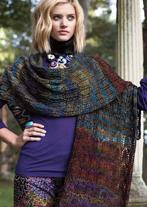
28. Lace wrap by Laura Bryant. Decidedly average lace wrap knit with Prism yarns in a way that it looks like it was knit with scraps out of the stash. $70 USD to knit this with the suggested yarns.

29. Wrap with belt by Shiri Mor. Odd construction on this; a back, like a sweater, with a scarf sewn to the shoulders of it and wrapped all around. Not sure why it then looks like a hippy vest. One size fits all, of course.

30. Infinity scarf by Amanda Blair Brown. This one pisses me off. It's a circular scarf, and those can be worn all kinds of different, USEFUL ways, wrapped around your head and neck to keep you warm without trailing on the ground. They don't show ANY of those ways, either here or on Vogue 360, they just plonk it around the model's neck and let it hang there. Big help on the styling. Idiots.
The last section isn't really a section. It's two mitten patterns that are in the front of the magazine with the techniques, yet they're numbered 31 and 32. This makes no sense to me. It also makes no sense to me how traditional Scandinavian mittens are anything but traditional; I fail to see any high fashion whatsoever. Mind you, they're nice mittens, look interesting, and will keep your hands warm. But, uh, fashion? Huh?

31. Snowball mittens, by Elinor Brown. "Give winter the thumb's up with luscious mitts that pair beautifully with your best winter coat." Oh geez. Anyway, they're nice mittens. Knit with cashmere, so I'm not sure how well they'll wear.
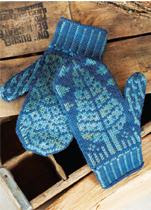
32. Tree mittens by Elli Stubenrauch. Nice. They're mittens. They'll keep your hands warm. Um. I like trees.
So there you go. A little better with sizes this time - I do think the bitching is getting through, condescending letters from the editor or not. Still looks like they stall at complex design, though. I wonder if part of the requirements for this issue was to keep the designs simple so they could be resized; all these patterns are fairly traditional in construction. No wild directional stuff. It'll be interesting to see what happens to sizing when the inevitable complicated knit shows up in their office, though.





